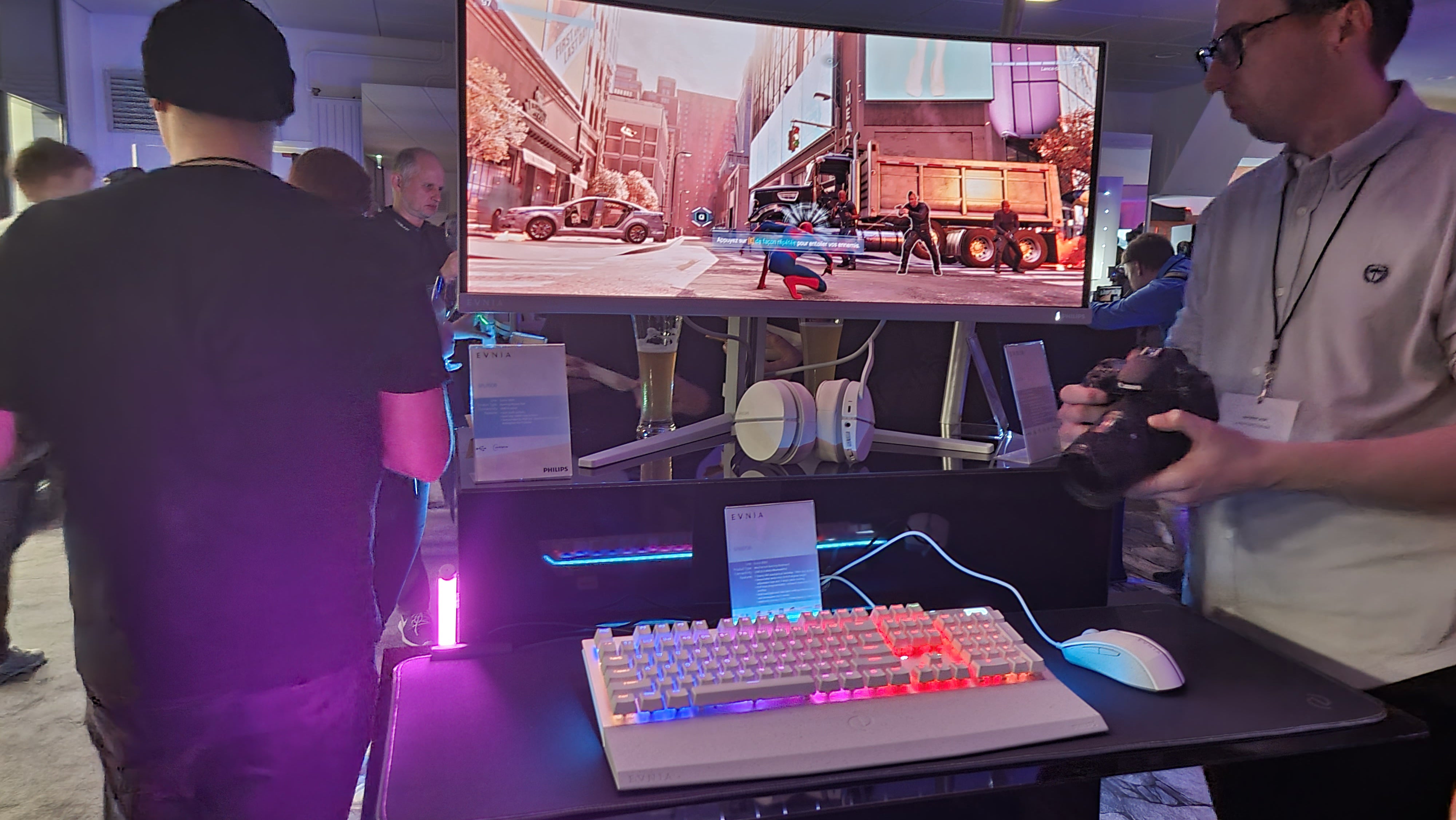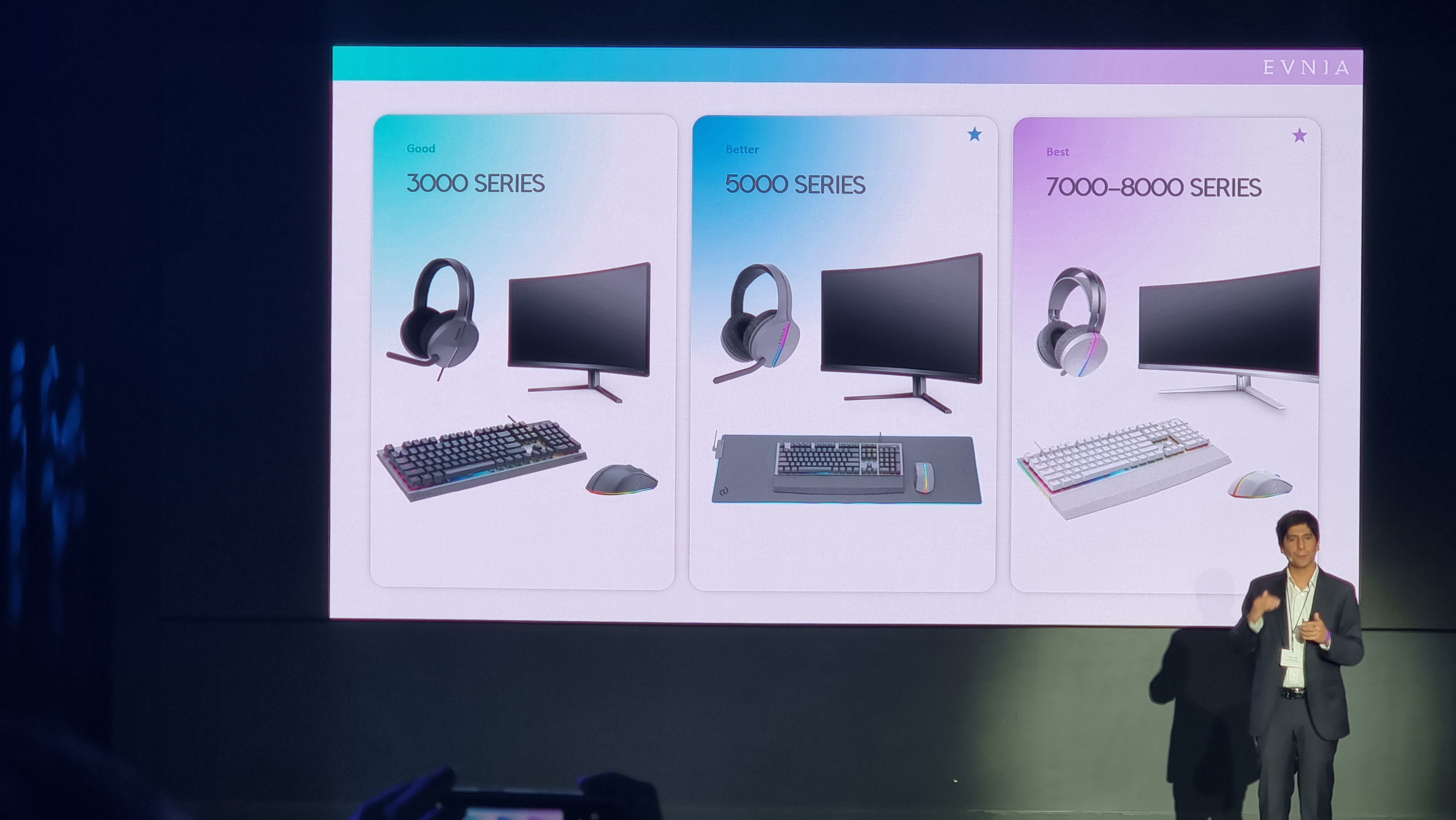
[ad_1]
At a launch event at the Stade de France on Thursday, Philips announced a brand new gaming brand, Evnia, with a full line of monitors, keyboards, mice and headsets. The name comes from the Greek Εύ and νοια and is said to translate as “wise thinking”, and plays into an overall healthy and inclusive atmosphere with a focus on “reinventing the rules” of computer peripherals. Ironically, this kind of belief is quite endemic among gaming brands, but Philips at least did some is playing to differentiate itself, designing products with refreshing off-white/grey colors, partially constructed with recycled materials and guided by Kenyan fighting games due to QueenArrow.
In addition to offering a slightly different look to your standard black-and-red gaming experience, the keyboards, mice, and headsets announced also held up well in the short test session we got, especially the keyboards, which offered some interesting features. top of solid foundations. These units were still pre-production models, but there is enough interest here to mention ahead of their planned release date early next year.
First, the SPK8708 full-size mechanical keyboard. Like other high-end Evnia peripherals, the SPK8708 is a fully wireless model that supports both 2.4GHz and Bluetooth, with the former offering lower latency and the latter wider compatibility and longer battery life. Like Philips TVs, it comes with Ambilight-branded lighting that spills out behind and around the keyboard, complementing the LEDs behind each keycap. A volume wheel in the top right corner appeared to have an integrated screen inside, which could offer some interesting options along the same lines as the DF favorite SteelSeries Apex Pro – although it didn’t seem to work in the unit we had access to. to
Otherwise, the white keyboard has a speckled-pattern wrist rest, supposedly made from recycled materials, that magnetically attaches. Inside, there are Cherry MX RGB switches, available in Red, Blue, Brown or Black varieties with varying levels of tempo and noise, and a 4000mAh battery that should provide days if not weeks of battery life. An interesting start, no doubt.
The same combination of solid essentials and some new ideas describes the mouse we tested (SPK9708), which offers a bright white color complete with mottled modern-looking sides and an interesting ribbed chassis with marked lines running down its center. In my hands, it was a pretty heavy mouse, but one that packs in a 20,000 DPI sensor for smooth tracking, as well as mechanical mouse buttons that felt solid, and dual connectivity over both a bundled receiver and Bluetooth. Again, expect to find RGB here with both a main strip in the center of the mouse, as well as an Ambiglow-style backlight effect.

Arguably the most exciting looking product was the higher end headphone in the range, the Evnia 7000 series headphone (TAG7208). This provides a white plastic frame next to a fabric, almost suede material for the ear poles, which I’ve found to offer excellent passive noise isolation and damping, not least in an event space filled with hundreds of press people, and is also surprisingly comfortable. .
I didn’t get a chance to test the headset’s audio, but other attendees told me it was quite distorted at times, but that might have been the way they were set up to handle someone’s incessant chatter and music. a nearby big band. Hopefully it won’t be the case that the 50mm drivers inside the headset offer that with wider testing. The multimedia controls offered somewhat good tactility, although the volume wheel had no resistance, which did not feel the best confession, but of course, these were samples.

With the mid-range 5000 series peripherals, there are some differences compared to the top Evnia products, as you might expect. They are wired instead of wireless and black instead of white, silver or grey, so look a little more ordinary than their higher-end counterparts. Not too much information was given about the features of the 5000 Series peripherals in the presentation, but what we do know is that Philips stated that it uses its own switches for its keyboard (SPK8508), although the samples were equipped with a lot of MX offers. When asked, they wouldn’t reveal who they partnered with to make their switches, but the reps around at the event assured me that they were custom made specifically for Evnia, as opposed to being off-the-shelf jobs. Otherwise, the keyboard appears to be a similar story to the more expensive one above – solid build quality, along with a speckled wrist rest, and RGB lighting to boot.
The mouse (SPK9508) itself continues with the black plastic and fabric sides, which make it quite comfortable to hold, although like its more expensive brother, it turned out to be quite heavy in the hand. Inside, there’s a 16,000 DPI sensor that’s still pretty solid, as well as customizable RGB lighting in the same places as before. To go with the mouse and keyboard, there’s also a spill-over mouse pad (SPL7508) for you to place your peripherals on, which also comes with an RGB backlight effect if you want it.
However, perhaps the biggest difference between the two lines sits with the headphones. The 5000 series headphones (TAG5208) change things up completely with their headband, which offers a strange rubberized support, as opposed to a bungee-style system as favored on the 8000 series. Other than this, it’s pretty much the same story, with suede earcups that are comfortable and offer solid isolation, as well as 50mm drivers and support for DTS X 2.0 surround sound, and a splash of RGB lighting.

All of these peripherals are configurable with Philips’ all-in-one software solution, Philips Precision Center, which will allow you to configure RGB lighting and program inputs in the same way as other manufacturers’ offerings. Interestingly, you can also save the profiles to the cloud, and re-download them elsewhere – which sounds useful for LAN cafe use, except you may have difficulties installing new software on someone else’s machine. No information on the prices for these 5000 and 7000/8000 series products, which is a shame, but what we do know is that they will arrive in June 2023, while the monitors will be in December 2022 to January 2023.
Without solid pricing information it’s still hard to give a firm verdict on the Evnia peripheral line, but first impressions suggest they should offer reasonable basics, with an extraordinary look and some interesting tricks that could make them a pick over more generic ones. offerings – but we’ll reserve final judgment until we’ve tested production models ourselves.
This article was based on a press trip to Evnia’s launch event in Paris; Philips paid for travel and accommodation.
[ad_2]
Source link
